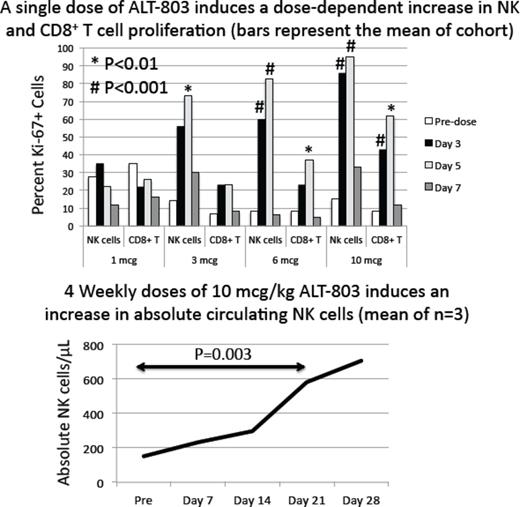Abstract

Disease-free survival after allogeneic transplantation for hematological malignancies may be enhanced with post-transplant immunotherapy. IL-15 is a homeostatic cytokine that stimulates both NK cells and CD8+ T cells, but unlike IL-2 it does not stimulate suppressive regulatory T cells. Physiologic IL-15 signaling occurs after trans-presentation with IL-15Rα to IL-15Rβ and IL15Rγ (common chains shared with the IL-2R). ALT-803 (Altor BioSciences) is an IL-15/IL-15Rα-Fc superagonist complex, which includes an activation mutation in IL-15 (N72D), a sushi domain to increase transpresentation, and an IgG1 Fc domain to increase serum half-life and stability. In preclinical mouse models, ALT-803 exhibits potent anti-tumor activity. We therefore performed a 'first-in-human' phase I open label dose escalation trial of ALT-803 in patients with relapsed hematologic malignancy after allogeneic hematopoietic cell transplantation (> 60 days) with no active GVHD and having >10% residual donor chimerism. Sixteen patients (AML, n=10; MDS, n=2; myeloma, n=2; ALL, n=1; NHL, n=1) received escalating doses of intravenous ALT-803 given weekly x 4 doses in 4 cohorts of 1 (n=6), 3 (n=3), 6 (n=4), and 10 (n=3) mcg/kg. Cohort 1 was expanded because of atrial fibrillation (grade 2 toxicity) in an AML subject with a prior history. One unevaluable subject in Cohort 3 who did not receive the minimum 3 doses of ALT-803 was replaced. There was highly reproducible and dose-dependent constitutional symptoms, consistent with immune activation (fevers and tachycardia) that peaked at 5-6 hours after each dose despite pre-medication with acetaminophen & diphenhydramine. Fever ≥103 degrees F was observed in cohorts 3 and 4 in patients receiving 6 and 10 mcg/kg, respectively, but was self-limited with resolution within 12 hours. These side effects correlated with ALT-803 dose-dependent increases in serum IFNγ and IL-6 levels 4 hours after dosing. Grade 2 hypotension (asymptomatic) occurred and responded to saline infusions, resulting in saline bolus prophylaxis in later patients. No patients experienced systemic capillary leak syndrome. Oxygen saturations were normal at all time points except in one patient (6 mcg dose) with an isolated 02 saturation of 88% and 89% five hours after doses 2 and 3, respectively. No dose limiting toxicities were observed. Dose dependent increases in CD8+ T cell and NK proliferation (Ki-67+) were observed at 3 and 5 days after the first dose of ALT-803 (Figure, top) with a slight increase in Ki67+ Treg and CD4+ T cells, but less than NK cells and CD8+ T cells. NK proliferation remained above pre-treatment baseline for 7 days in the 10 mcg/kg cohort, resulting in a sustained increased in absolute NK cells for 28 days (Figure, bottom). Functional studies at the 10 mcg/kg dose showed an increased frequency of NK cells that degranulated against K562 targets and produced IFNγ after IL-12/IL-18 stimulation. Clinical responses occurred in 2 patients with stable disease 1 month after the last dose of ALT-803 and one complete response. This 69 y/o man had recurrent RAEBT (9% blasts) with complex cytogenetics (monosomy 7 with cytogenetic evolution in 5/20 metaphases), relapsing after prior second unrelated donor transplant with 46% donor chimerism at the time of treatment. After 4 doses of ALT-803 at 6 mcg/kg without DLT, he developed a biopsy proven cutaneous grade II GVHD that resolved with topical steroids alone. His follow-up bone marrow biopsy revealed 3% blasts, normal karyotype, 93% donor chimerism with normalization of blood counts (Hgb from 9.6 to 12.5, platelets from 61K to 168K, WBC from 1.7 to 4.2 and ANC from 400 to 1400 from pre-therapy to one month post-therapy). An additional patient had grade II skin GVHD with disease response measures pending. This phase I trial demonstrates that ALT-803 safely induces proliferation of functional NK cell and CD8+ T cells with in vivo cytoxicity. Recent pre-clinical data suggest that subcutaneous dosing of ALT-803 can decrease peak serum concentrations, increase half-life and preferentially distributes to lymphoid tissues potentially optimizing drug delivery. The ongoing trial now utilizes subcutaneous dosing at 6 mcg/kg followed by dose escalation. IL-15N72D /IL-15Rα-Fc superagonist complex is a promising new therapeutic strategy for the treatment of relapse, a major obstacle after allogeneic transplantation for high risk hematologic malignancies.
Miller:Coronado: Speakers Bureau; BioSciences: Speakers Bureau; Celegene: Speakers Bureau. Jeng:Altor BioScience Corporatoin: Employment. Wong:Altor BioScience Corporation: Employment, Other: stockholder of Altor Bioscience Corporation.
Author notes
Asterisk with author names denotes non-ASH members.

This icon denotes a clinically relevant abstract


This feature is available to Subscribers Only
Sign In or Create an Account Close Modal